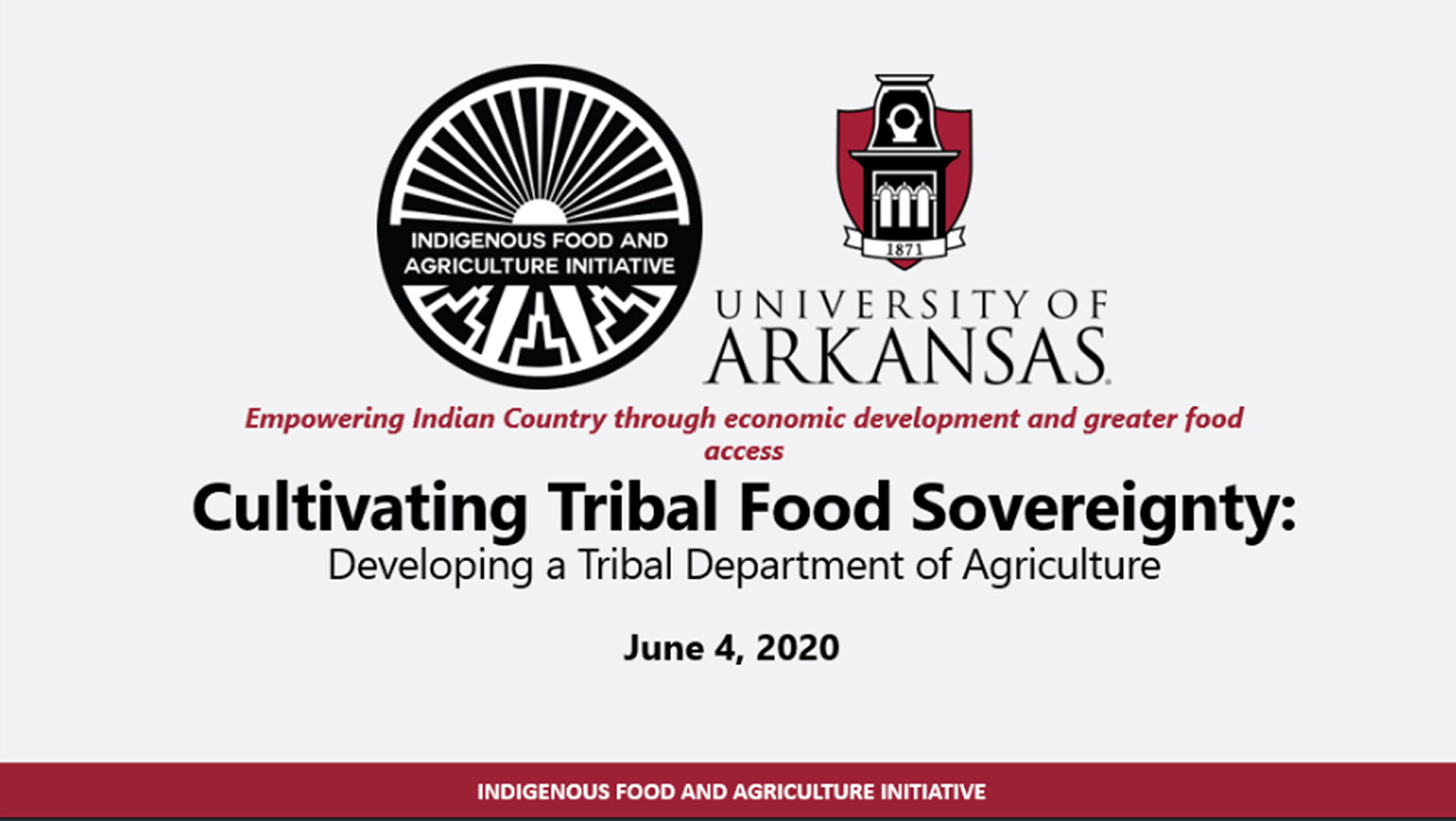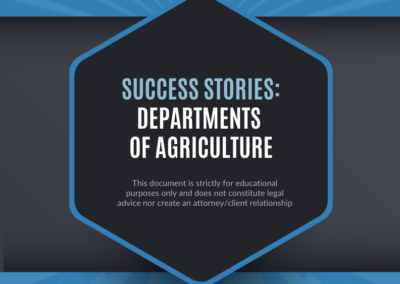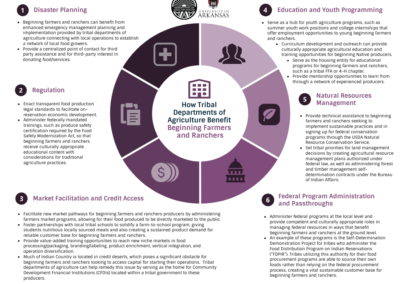Cultivating Tribal Food Sovereignty
Disruption to food systems, uncertainty, and food access inequities exacerbated by COVID-19. How can tribes cultivate food sovereignty, build healthy and traditional foodways, and facilitate agricultural production?
EATS Academy
The Empowering Agriculture through Tribal Sovereignty (EATS) Academy is an ecosystem of trainings and resources developed by the Indigenous Food and Agriculture Initiative to support Tribal governments and producers develop robust food systems throughout Indian Country.
As needs for EATS Academy resources change and evolve for Tribal governments and producers, the academy will reflect updated information as it becomes available. Sign up to receive communications on updated resources and news related to the Indigenous food and agriculture.
New resources coming soon!
- Trends in Agricultural Markets
- Leveraging and Scale Certifications to Navigate Market Channels
- Special Supplemental Nutrition Program for Women, Infants, and Children (WIC)
- Vendor Certification
- Introduction to Tribal Trade Issues

Support for the EATS Academy has been generously provided by the Walmart Foundation.
This centralized resource ecosystem is intended to bridge gaps in information available to Tribal governments and producers. This is in no way complete, but it is a foundation for Tribal stakeholders to start their work in Tribal food sovereignty efforts.
Your feedback is important – we want to hear from you! What educational resources are missing? Contact our Manager of Tribal Enterprise Development, Will Seeley: wseeley@uark.edu.
Start below by sorting the information based on which category best fits your role, interests, goals, or areas of expertise.
Model Tribal Food and Agriculture Code
- Traditional Foods and Seeds
- Health and Nutrition
- Agricultural and Food Safety
- Conservation
- Land Use
- Agricultural Business Entities
We are grateful to the Shakopee Mdewakanton Sioux Community through their Seeds of Native Health campaign, MAZON: A Jewish Response to Hunger, Agua Fund and the W. K. Kellogg Foundation for their generous support of the Project.
Why A Model Food Code?
In 2015, the Indigenous Food and Agriculture Initiative was honored to receive funding support from three critical partners that each brought resources forward to support the building of a “Model Comprehensive Food and Agriculture Code for Indian Country” (Project). Shakopee Mdewakanton Sioux Community (as part of their Seeds of Native Health campaign launched in 2015) brought our initial support in the amount of $250,000 with a match from MAZON: A Jewish Response to Hunger in the amount of $50,000. Agua Fund, Inc. approached us shortly thereafter and brought an additional $50,000 for year one and $50,000 for year two to support this work.
We are deeply grateful for each of our founding funding partners’ commitments, belief in our work, and generosity to launch this work that we believe will be one of the more foundational actions to realize true tribal food sovereignty, improvement in native health and well-being by controlling the policy environment surrounding food and agriculture, and improvement in food access and food-based prosperity in our communities.
During this initial reporting period, the Model Food Code Project Team has gained valuable insights into the needs and challenges of Tribal governments, citizens, producers, and food businesses, all of which may be remedied by the passage of the model laws produced by Project Team. These insights have come from across Indian Country through a series of in-person Regional Roundtables. Community and leadership engagement in Indian Country is absolutely necessary at each stage as this project moves forward.
At each Regional Roundtable, Project Team members presented a brief overview of the project, then dialogued with attendees about the needs and challenges that are important in their Tribal community surrounding food and agriculture. The responses from attendees have been wholly positive and incredibly varied, covering topics from incorporation of traditional ecological knowledge in production, to conservation of land to taxes and land leasing regulations. Many suggestions from attendees relate to the code’s content/sections, but the Project Team has also received many comments about the format and delivery method of the code as well as deep questions about Tribal sovereignty as expressed through the code. To date, the Project Team has conducted nearly 20 Regional Roundtables with more to follow in the months and years ahead.
Advisory Body for the Project
The Advisory Body is a panel of experts who periodically advised the Project Team, helping to shape the content of the code work as well as the ultimate delivery and presentation of the code to Tribal governments. This body was assembled quickly in the first part of Phase I and convened its first gathering on November 20, 2015, in Fayetteville, Arkansas. Half the members attended in person, and half attended via distance technology. The second meeting, conducted entirely via distance technology, occurred on February 29, 2016. Summaries of these meetings, and a draft agenda for the third, can be found below, following the list of Advisory Body membership.
All members have recognized expertise in an area that is critical to the successful drafting and delivery of the code. The body includes experts in agricultural production, agricultural economics, Tribal law and governance, federal Indian law, land tenure in Indian Country, Tribal economic development, the role of Native beginning farmers and ranchers, and more. Over the course of Phase I, new members were added to this body as it became apparent that their expertise would be relevant.
- Chris Georgacas, President/CEO, Goff Public (representing Shakopee Mdewakanton Sioux Community) Minneapolis
- Julie Ralston-Aoki, Staff Attorney, Public Health Law Center
- Joel Williams, Staff Attorney, Native American Rights Fund
- Billy Barquin, General Counsel, Kootenai Tribe of Idaho
- Carrie Frias, General Counsel, Pueblo of Pojoaque
- Derrick Lente, Rancher and Member of the Council for Native American Farming & Ranching (USDA)
- Sara Hill, Secretary of Natural Resources, Cherokee Nation
- Crystal Echo Hawk, President/CEO, Echo Hawk Consulting
- Adae Romero Briones, Attorney Advisor
- Abi Fain, Attorney, Pipestem Law
- Dr. H.L. Goodwin, Professor of Agricultural Economics, University of Arkansas School of Law
- Kelsey Ducheneaux, Youth advisor
- Marcus Grignon, Youth advisor
- Kekek Jason Stark, Lead Attorney, Lac Courte Oreilles Band of Lake Superior Chippewa Indians




























